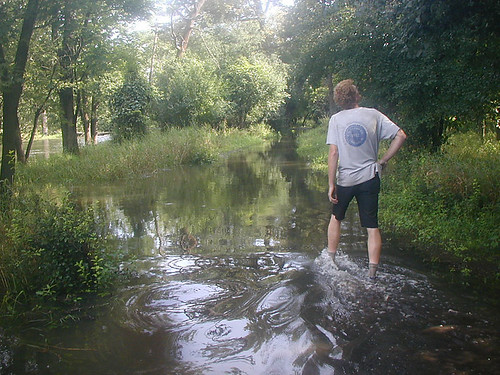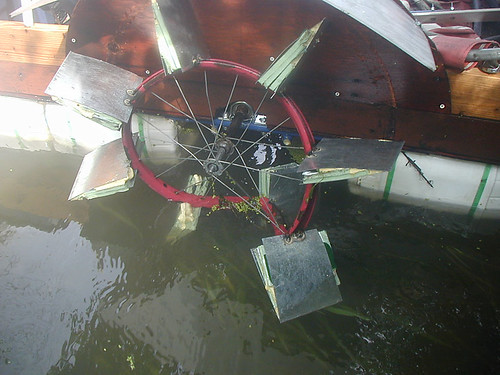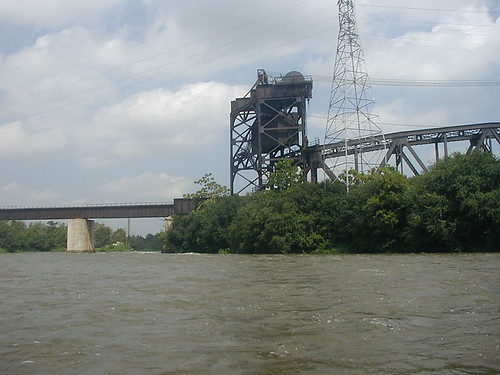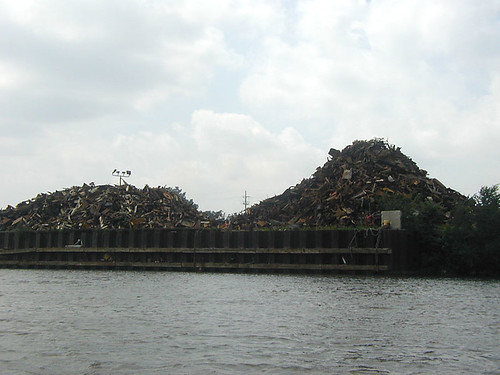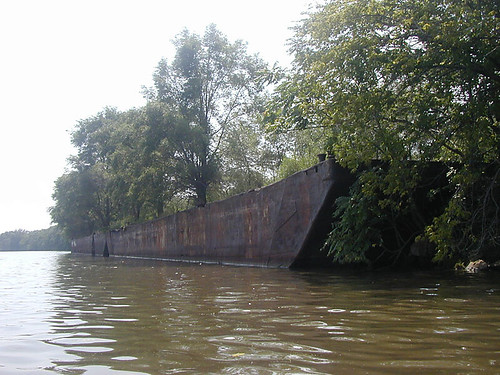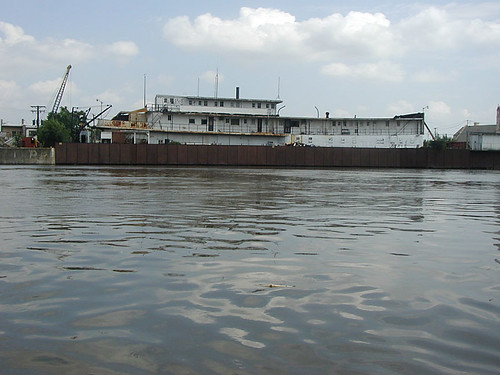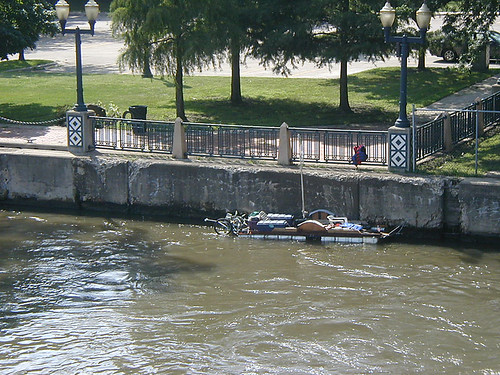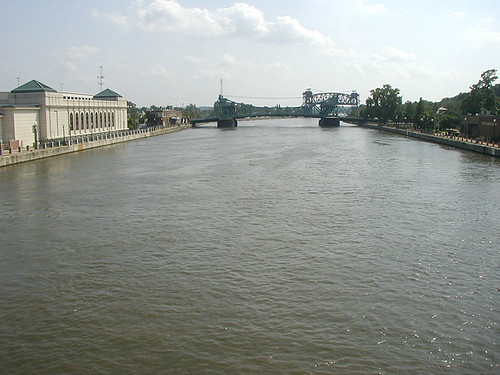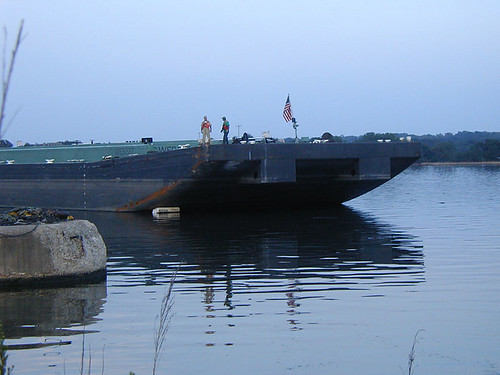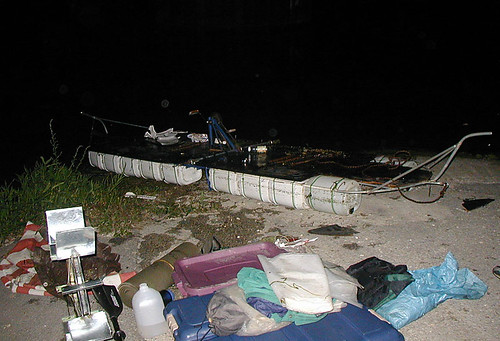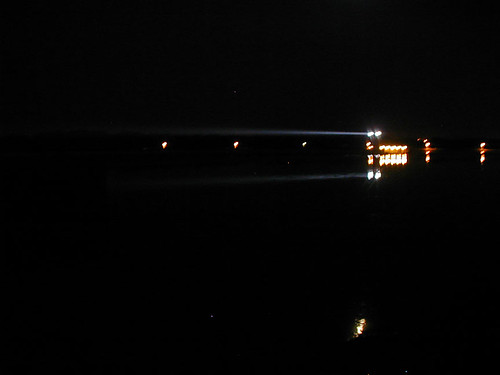Another muggy night of restless sleep thinking of the dangers ahead. Another thunderstorm in the middle of the night shaking the tent wildly and then disappearing off into the night. We were up before the park opened and packed our things away on the boat before an egg breakfast in town.
I guess we were dragging our feet a little before heading out into the fast current and down to meet the unknown rapids. Eventually we changed into our wet river clothes and headed down the flooded path to pull the boat out of its hiding place.
The first task was to paddle upstream out of a little side channel to join the fast water around a small island. Our slow boat had to struggle against the current to get around some bushes. But immediately we had a problem. The right paddle wheel, the one that had been bent a few days before, suddenly was grinding against the wood sides of the boat. Floating back into the weeds we got out to look. After bending the wheel back into shape so many times, the rim itself was starting to crack in half. Many of the spokes were loose, and without a tire on the wheel, several of the spoke nipples had worked themselves loose and disappeared along the way, leaving less to hold the wheel together.
I tightened all the spokes to true the wheel as best I could and we pushed off into the current again and pulled hard upstream. This time, the paddle wheel gave a pop and snapped! Well, what to do now? We removed the busted wheel and threw it on the back of the boat.
We thought one of us might have to swim a rope across to the other side to pull the boat upstream into slower water, but on the third try with a better path staying out of the fastest current we pulled hard back to the flooded picnic tables even with only one functional paddle wheel.
Taking a breather here we discussed the best strategy for the rapids ahead. Even getting out of this side channel and into the racing water around the island looked like it would take some planning. If we didn't get ourselves into the right-hand side of the fast flow, we'd be pushed back into the side channel, or onto a pile of driftwood at the head of the island that would not be a good place to get stuck.
Moving gently along the edge of the grass we made it upstream as far as possible in the quiet water, lined up the front of the boat at an angle and then charged out into the racing stream. Pulling hard with the kayak paddle we made it to the far side of the flume, turned the bow downstream and made it perfectly into the current running to the right around the island. Whoo hoo! Now we were on our way!
Riding the fast water around the island we made it back into the reunited river and drifted for a while. With only one paddle wheel we were constantly turning to the right, so there were no more lazy days for the front paddler. It took a strong pull of the kayak paddle to match the push of the paddle wheel and keep us heading in a straight line. Now it was clear how strong the paddle wheels had been in driving us along.
The floodwater pushed us along quickly and we drifted for a while through wild country without seeing any houses. When we reached the rapids our plan was to stop and scout them out to see if they were runnable. Besides being bulky and difficult to maneuver, our raft had metal bars hanging down below the floats, the dropouts for attaching the trailer wheels. If there were any logs or rocks ahead, the worst thing that could happen would be to become hung up in the middle of fast water and flip over.
But first we rounded a bend and spotted another low bridge ahead. Hadn't we had enough of these yesterday? This one seemed completely clogged with logs yet again. And here there were no roads along the banks, only flooded meadows without any easy way to land and check it out. But sticking to the left shore we found a passage through the grass and stagnant water over to a rugged bank.
Scrambling through the buckthorns, we came to a high chainlink fence topped with barbed wire. There wasn't much of a trail, but we were able to crawl along the fence to a low spot to squeeze under it. Inside the fence was a cleared area and some kind of settling pond used by a nearby power plant, and beyond was our road over the bridge. A constant stream of dumptrucks roared and downshifted over the bridge and around the corner to some nearby gravel pit. Ahead of me, Mike found another place to squeeze out of the fenced area and duck through the weeds down toward the head of the bridge. "Its clear," he reported, far on the left side.
So, back through the brambles and back on the boat. Creeping slowly along the left shore, the boat was difficult to control with only one paddle wheel. The fast current pulled us one way, and the paddle wheel pushed another. If we were going to make it into the right chute under this bridge pointed in the right direction we'd need more control than that. Fortunately there was a little eddy along the shore just before the bridge, so we were able to line up correctly before heading under the bridge instead of drifting sideways and smashing into the piers. Another bridge cleared and on we go!
After a while on the open river we saw islands ahead and knew this was the rapids. There must be some strata of bedrock just below the surface here that resists the free erosion of the muddy river and splits it around small islands. I know now that they are known as Fishnet Rapids for the way they divide around the many islands and are one of the few sets of rapids in northern Illinois.
But as we drifted closer we had no idea what to expect. Choosing a channel around the first island we chugged across the current to place ourselves in the center of the quickening stream and turn the bow downstream. Not much else was possible except to keep pointing downstream.
As we bobbed along I knew that we were amazingly lucky that the Des Plaines was in full flood right when we'd reached this point. With our low clearance there was no way we'd ordinarily be able to run rapids in our raft. But the high water covered all rocks and cleared all obstacles in our path. Our raft proved itself very stable as we dived straight ahead into 3-foot standing waves washing completely over our decks, but popped right out on the other side. Unlike an open boat, we had no worries of taking on water and pushed directly through the waves instead of over them. Up and down we bounced down the raging current.
Now and then the river would widen and calm briefly, and we'd line ourselves for another run around another island, or make quick moves to avoid a stump or big rock barely breaking the surface ahead. The most frightening parts were staying well clear of the water stacked up around piers of several bridges we raced up on quickly. There wasn't much chance of fighting against the current, so we just tried to stay in the center and let it carry us along through the clear channel.
In the middle of one fast section there was a BOOM! and the boat jerked for a second. We might have hit a submerged rock or underwater monster, but in the murky water it was impossible to know. Fortunately it was a glancing blow and didn't stop us or change our course in the stream.
To anyone on a whitewater rafting trip in a rubber boat, no doubt Fishnet Rapids would seem like a fast but tame roller coaster, but to us in our homemade raft it was a wild ride into the unknown. There never was any opportunity to scout out what was ahead, and since the river runs through long sections of industrial private property, there was no one around to even watch us. The bridges we passed under were empty of traffic without a even lone fisherman to see us if we'd swamped in the waves. Only at the very end, when the river ran down one last drop under a railroad bridge into the flatwater of the shipping channel again, only here a switching engine stopped on the tracks above and the engineer watched as we lined up in the middle of the chute between the tall bridge piers down into the big channel.
Now we were back in the industrial world of the shipping channel. Across the wide water ahead we could see the bridges and towers of downtown Joliet. On the right side of the river the fast waters of the Des Plaines still pushed us along, but now there was also a south wind across the flat water pushing us back.
After a lunch of leftover pizza hanging out below a scrapyard dock, we decided it would be appropriate to throw our busted paddle wheel onto the pile. I can't imagine its legal to store scrapmetal in piles right next to the water, and the breakwall was cluttered with little metal pieces that had spilled down from above. We even spotted some bike wheels up there, and if we were crafty enough we might have figured out how to fix the broken wheel with a replacement rim scavenged right here. But for now we were tired and couldn't think of how that would have been workable.
Continuing along against the wind we passed more old barges used as riverside landscaping. These barges were somehow buried in the bank and had a well established forest of trees on top. How long had these been here? They were like natural occurences of Robert Smithson's Floating Island.
Coming in to Joliet there were finally houses along the river bank. A quaint neighborhood of working class houses lined a quiet street along the river wall, with homemade rock gardens and boat launches along the bank. Across the river we passed the mouth of the old I&M canal and later an ancient sternwheeler steamboat in drydock behind fences in an industrial area. Now we knew we were on a big old river with many stories.
Despite the wind pushing us backwards, the current was really moving along here. I knew there was a park along the water in downtown Joliet where we could get out, but looking ahead we didn't see any boat landings. It was just one long concrete wall all the way through downtown on both sides. Across the river we could see cars driving on roads below the water level behind the river walls, which looked very strange.
It seemed that our only chance at getting out to explore Joliet would be one of the little ladders that appeared occasionally along the wall. But they came up fast, and we missed one or two from not catching them in time. Finally we passed through a little passage under a bridge and there was a ladder leading right up to the park. I grabbed it and quickly tied our lead rope to a rung.
But then suddenly two yachts appeared under the bridge cruising down the river. Slowly, but the boats were large enough that they threw a powerful wake, which bounced off the walls and the pilings of the bridge crazily, throwing us from side to side. Tied by the rope and pinned against the wall by the fast current we scraped on the wall and stuck while the waves pushed us upward, nearly flipping the boat over. Luckily we were able to push off from the wall with our broken paddles to keep the boat steady as the cacophany of waves bounced back and forth across the river. But it was too much for the left paddle wheel: the grinding on the wall snapped the axle and Mike caught it before it fell off completely.
So now we had lost both paddle wheels. We had thought that any of the obstacles of the last two days might be the dead end of the journey, but we hadn't expected mechanical problems to be the reason. Without the steady paddle wheels it would be difficult to continue against this wind, and playing on the water among towboats and powerboat wakes without power seemed a dangerous prospect. Adding to that, we had discovered that I'd stupidly lost the river maps at our morning campsite, so we didn't really know where to go.
We did know we couldn't pull the boat out of the water here, and for the moment I couldn't even untie the ropes to cast us off and try for a better landing downstream. Every time I walked forward to pull in the rope, the bow tipped downward, and as the fast current caught the deck, it pushed the front of the boat down underwater like the planes of a submarine. If I didn't step back quickly we'd dive straight down into the current.
Eventually we switched positions on the boat and Mike was able to pull us in a little closer while I pushed us forward along the wall with a broomstick. But as he grabbed for the rope on the ladder there was a big water snake resting on the rung right beside the knot! He knocked it into the water with a paddle and climbed up the ladder. It seemed that another passing boat wake might easily flip our raft, but we decided to climb out and explore Joliet and find a library with the internet to print out some more river charts.
It was a beautiful sunny afternoon on land as we hopped over a fence into Bicentennial Park, we were worn out from all the morning's excitement. A passerby coming down off the bridge yelled at us "What's that?" and we proudly said "Its a boat!" But the woman drew closer and it was obvious she was completely drunk. "What's that?" she asked again. "Its a boat." What was this woman's problem? She kept demanding some explanation but didn't understand a single thing we said. Mike began to walk away and she shouted. "Hey! Why you bein' snippy with me?!? Whats you're problem?? I'm just askin' you a question!" But there was no turning her back. She screamed at us for two blocks that we were assholes at the top of her lungs.
Across the bridge, we looked back at our fragile boat as if it might be the last time. Two more citizens of Joliet asked us about our project, where we'd come from. They were also stumblingly drunk in the middle of the afternoon. "You goin' to the casino?" they assumed, but at least they were in a happier mood than the first woman we met and they directed us to the library.
At the library there were so many bureaucratic steps to get a password to get on the computer. We were directed from one librarian to another to receive permission, it really made no sense. It seemed that people were staring at us when we came in the door, and looking down I suddenly realized how dirty my clothes were, from the rain and mud, and mostly crawling under that fence this morning. But really we were no dirtier than many of the other hard-luck cases hanging out at the Joliet library so maybe it was something else that made us stand out.
With the many security measures on the library computers, we were not able to open the pdf files of the river maps. It didn't matter because we weren't able to print from this computer anyway, only from the other computers that required a Joliet library card or special permission from some other administrator. But we managed to spot a suitable landing point downstream from Google satellite maps and decided it would be our ending point for the trip.
Returning to the bridge, our boat was still there as we left it. The river was clear of all traffic and we cast off without much trouble. The plan was to follow the river wall on down for a mile or two past the I-80 bridge, beyond an industrial area to what looked like a beach not far above the Brandon Road dam. Just to keep moving, we put the reattached the one paddle wheel to the side with the intact axle and were back at half power instead of none.
Drifting to the end the park, a kid followed along on his bike and waved goodbye. On down a ways we came across four stumblebums sitting on the river wall watching the tide roll away. "Hey, where you guys headed?" one asked. They all had questions and we tried to answer in the little time before the current pushed us on. But one drunk was the most boisterous: "This town's the shittiest shithole ever," he lamented. "You gotta build a boat like us and float out of here," we said, but we must have said the wrong thing. "I'm gonna call the coast guard on yer asses!" he suddenly snapped. We thought he was joking, but then he was only angrier. "I'm serious! I got a cell phone right here! I'm gonna call the coast guard on yer asses, assholes!!" His friends looked embarassed but they did nothing to discourage him. As we drifted quickly away we could hear him screaming at us as loud as he could: "Assholes!! Assholes!!" Far downstream all was quiet and then a faint "Assholes!!!"
What was up with that? Mike and I recollected that half the people we'd talked to in Joliet were missing front teeth. What a rough town. Glad to be out of there and back on the happy river.
It was slow going against the wind pedalling and paddling, creeping around parked barges and under gusty lift bridges. There were people on several parked boats who chatted a bit, and workmen in boatyards who came out to see us pass. "We'll trade you boats!" Mike yelled at them and they took pictures of us.
Finally we made it to the beach landing and there was a little restaurant with a riverside patio right there. Perfect! And there were some guys on shore running out to ask us questions about our boat. We landed and went into the bar where a man named Keith told us he'd come down from the boatyard above to talk to us, and bought us drinks, and we chatted for almost an hour. He was a towboat captain, working on a harbor boat that assembled tows here in Joliet, but he'd also done work as a diver and underwater welder, flew helicopters, and other exotic trades. He loved sailing, and gave us lots of advice on adding a real sail to our boat, something that would let us tack across the water into a wind like today's. He told us some local riverboat tales and listened to our own little one, and it turned out to be a real pleasant afternoon.
But we'd already decided without really discussing it that this would be the end of our journey. Keith seemed sure they'd never let us through the lock in such a small craft, without lights, a marine radio, a rescue kit or fire extinguisher. We did have some makeshift navigation lights but had yet to rig them up. I don't know what we would use a fire extinguisher for.
Later we walked down the road to see the lock and dam and try to find out for sure if it was possible to pass through. The night watchman there told us we'd have to ask the lockmaster for special permission, that even canoes were often denied permission to lock through, and the master wouldn't return until 8 the next morning. It was disappointing. In the locks on the Mississippi in Minnesota they often welcome canoes and small craft, but here they seemed to be interested only in towboats and industrial cargo. Like most of the rest of our travels along the Sanitary Canal, there is little room for little boats.
Standing on shore we watched the big boats wrestle barges back and forth in the staging area above the dam. It was surprising how much activity there was out there on the water in the dusk.
We weren't really planning on continuing so late in the day without knowing where the next landing downstream might be, but it would have been fun to go through the locks. So instead we called a friend for a ride and started breaking up the boat so that it would fit into a pickup truck. Kind of sad to spend so much time building a project and then tear it apart.
Andrew arrived with the pickup just as we got the boat separated into halves. The frame we will keep if we want to continue again next year, the decking and boards will be easily replaceable. Stacking the pieces in the back of the truck yet another wild thunderstorm was moving in, and we just managed to grab all the gear in the dark just as the rain began to fall. Even in wind-whipped rain and lightning all around it only took an hour or so to cover the distance we'd come in five days.
